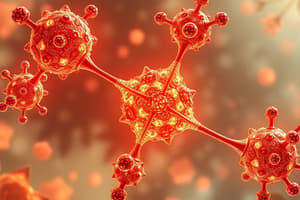Podcast
Questions and Answers
What is the primary factor that affects the strength of London dispersion forces between molecules?
What is the primary factor that affects the strength of London dispersion forces between molecules?
- Pressure
- Temperature
- Mass of the molecules (correct)
- Type of molecules (polar/dipole, non-polar)
What is the correct classification of intermolecular forces that exist between different molecules?
What is the correct classification of intermolecular forces that exist between different molecules?
- Ionic bonds and metallic bonds
- Covalent bonds
- Intramolecular forces
- London dispersion forces, dipole-dipole interaction, and hydrogen bonding (correct)
What is the primary function of intramolecular forces between atoms?
What is the primary function of intramolecular forces between atoms?
- To affect the strength of London dispersion forces
- To influence the type of molecules (polar/dipole, non-polar)
- To mediate interactions between different molecules
- To keep the atoms of the molecule together (correct)
What is the relationship between the distance between molecules and the strength of London dispersion forces?
What is the relationship between the distance between molecules and the strength of London dispersion forces?
What are the three types of bonds between atoms?
What are the three types of bonds between atoms?
What is the primary difference between intermolecular forces and intramolecular forces?
What is the primary difference between intermolecular forces and intramolecular forces?
What is the correct classification of electrostatic attraction and repulsion?
What is the correct classification of electrostatic attraction and repulsion?
What is the primary function of the 'Get the Gist' strategy?
What is the primary function of the 'Get the Gist' strategy?
What is the primary function of intermolecular forces?
What is the primary function of intermolecular forces?
What is the relationship between the mass of molecules and the London Dispersion Force (L.D.F)?
What is the relationship between the mass of molecules and the London Dispersion Force (L.D.F)?
What type of intermolecular force occurs between polar molecules?
What type of intermolecular force occurs between polar molecules?
What is the weakest of the intermolecular forces?
What is the weakest of the intermolecular forces?
What is the purpose of intramolecular forces?
What is the purpose of intramolecular forces?
What is the relationship between the distance between molecules and the London Dispersion Force (L.D.F)?
What is the relationship between the distance between molecules and the London Dispersion Force (L.D.F)?
What is the type of bond that involves the sharing of electrons?
What is the type of bond that involves the sharing of electrons?
What is the cause of Dipole-Dipole Interaction?
What is the cause of Dipole-Dipole Interaction?
Study Notes
Intermolecular and Intramolecular Forces
- Factors that affect interactions between molecules of a chemical substance include: • Temperature • Pressure • Type of molecules (polar/dipole, non-polar – ionic, covalent) • Forces (electrostatic attraction and repulsion, van der Waals)
Types of Interactions
- Two main types of interactions between atoms and molecules: • Intermolecular forces • Intramolecular forces
Types of Bonds
- Three types of bonds between atoms: • Ionic bonds • Covalent bonds • Metallic bonds
Intermolecular Forces
- Defined as the forces that mediate interaction between different molecules
- Include: • London Dispersion Force (L.D.F) • Dipole-Dipole Interaction • Hydrogen Bonding
London Dispersion Force (L.D.F)
- An interaction that exists between all molecules
- Weakest of the intermolecular forces
- Characteristics: • Inversely correlated to the distance between molecules • Directly proportional to the mass of the molecules • Increases as molecule mass increases
Dipole-Dipole Interaction
- Interaction of polar molecules
- Atoms that are partially negatively charged attract atoms that are partially positively charged in another molecule
- Caused by the difference of electronegativity of the atoms in molecules
Studying That Suits You
Use AI to generate personalized quizzes and flashcards to suit your learning preferences.
Description
Explore the factors that influence the interactions between molecules of a chemical substance, including temperature, pressure, and molecular type. Identify the two main types of interactions between atoms and molecules.




